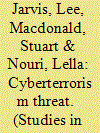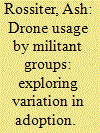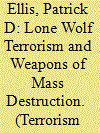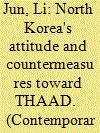|
|
|
Sort Order |
|
|
|
Items / Page
|
|
|
|
|
|
|
| Srl | Item |
| 1 |
ID:
132231


|
|
|
|
|
| Publication |
2014.
|
| Summary/Abstract |
This article reports on a recent research project exploring academic perspectives on the threat posed by cyberterrorism. The project employed a survey method, which returned 118 responses from researchers working across 24 different countries. The article begins with a brief review of existing literature on this topic, distinguishing between those concerned by an imminent threat of cyberterrorism, and other, more skeptical, views. Following a discussion on method, the article's analysis section then details findings from three research questions: (1) Does cyberterrorism constitute a significant threat? If so, against whom or what?; (2) Has a cyberterrorism attack ever taken place?; and (3) What are the most effective countermeasures against cyberterrorism? Are there significant differences to more traditional forms of anti- or counterterrorism? The article concludes by reflecting on areas of continuity and discontinuity between academic debate on cyberterrorism and on terrorism more broadly.
|
|
|
|
|
|
|
|
|
|
|
|
|
|
|
|
| 2 |
ID:
160998


|
|
|
|
|
| Summary/Abstract |
Judging by recent media reporting and pronouncements by senior US military and security officials, the use of drones by militant groups is both reshaping conflict between armed non-state actors and state parties and now presents a grave and direct threat to nations in the West and elsewhere. But does this threat warrant the attention it is currently receiving? To answer this question, this article surveys how various militant groups have used drones both tactically on the battlefield and for wider strategic purposes. Closely examining how drones have been employed and by whom provides a basis for understanding variation in adoption. The article shows how drone usage or non-usage is highly contingent on the setting of the conflict, the aims of different groups, and the capacity of groups to adopt the technology. Though advances in drone technology could make the use-case more appealing for militant groups, drones will be subject to the same back-and-forth, techno-tactical adaptation dynamic between adversaries that have accompanied prior military innovations.
|
|
|
|
|
|
|
|
|
|
|
|
|
|
|
|
| 3 |
ID:
098862


|
|
|
|
|
| Publication |
2010.
|
| Summary/Abstract |
The administrative expenditure of China has been growing rapidly in the past decades. This paper examines the forms and causes of government waste hidden in the high levels of administrative expenditure. Based on the findings, several specific policy suggestions are made.
|
|
|
|
|
|
|
|
|
|
|
|
|
|
|
|
| 4 |
ID:
133336


|
|
|
|
|
| Publication |
2014.
|
| Summary/Abstract |
A ground based interceptor (GBI) missile launched on 22 June 2014, carried the new capability enhancement II Exoatmospheric kill vehicle (EKV) to its first successful intercept of a ballistic target that was shielded by accompanying countermeasures.
|
|
|
|
|
|
|
|
|
|
|
|
|
|
|
|
| 5 |
ID:
132370


|
|
|
|
|
| Publication |
2014.
|
| Summary/Abstract |
Today, the specters of lone wolves and autonomous cells acquiring and using chemical, biological, radiological, and nuclear (CBRN) weapons of mass destruction, whether in their traditional military forms or the more non-traditional industrial forms, seems less far-fetched. Fortunately, military CBRN agents and weapons are not normally accessible to lone wolves or autonomous cells and are often located in highly secured areas. Therefore, lone wolves and autonomous cells may be drawn to materials similar to CBRN located in less secure areas. These commonplace industrial chemicals, biological contaminants, and radioactive materials could be used to cause disruptions or mass casualties. The dual use nature of these materials and technologies enables them to be turned into weapons and delivered by nonmilitary means. Future "over-the-horizon" threats, such as the proliferation of new biotechnologies and amateur do-it-yourself capabilities, pose a risk that lone wolves could develop weapons at a time when travel, access to knowledge, and dual-use technologies, in the globalizing environment, make lone wolf terrorists more dangerous. Thus, the author explores existing countermeasures, such as laws, strategies, passive and active measures designed to stop these dangerous threats. In particular, capabilities to prevent, protect, respond, and recover from CBRN terrorist acts are examined.
|
|
|
|
|
|
|
|
|
|
|
|
|
|
|
|
| 6 |
ID:
175741


|
|
|
|
|
| Summary/Abstract |
The threat of chemical, biological, radiological and nuclear (CBRN) terrorism is widely attributed to collective actors based on a religious ideology, e.g. globally operating Salafi-jihadist groups like al-Qaeda or ISIL. Only limited attention has been given to the CBRN threat of violent domestic extremists in general or far-right terrorists specifically. Nevertheless, a number of incidents involving far-right activists and CBRN agents in Western countries are known to the public, even though these have had comparatively little impact on public threat perception. This study systematically collected public information about far-right CBRN incidents to identify their main characteristics. The authors were able to identify 31 incidents in Western countries since 1970, which display features contrary to generally assumed forms of CBRN terrorism. Far-right CBRN terrorism appears to be predominantly a lone-actor phenomenon oftentimes involving middle-aged and comparatively well-educated male perpetrators, mostly motivated by non-religious forms of far-right ideology (i.e. neo-Nazism, non-religious white supremacism) and indiscriminately targeting victims. Overall, far-right actors attempting to weaponize CBRN agents have been few and generally technically inept. However, the characteristics of the plots pose potential challenges for effective counter-measures and intervention, should the number of actors or the technical sophistication of plots increase in the future.
|
|
|
|
|
|
|
|
|
|
|
|
|
|
|
|
| 7 |
ID:
156312


|
|
|
| 8 |
ID:
163625


|
|
|
|
|
|
|
|